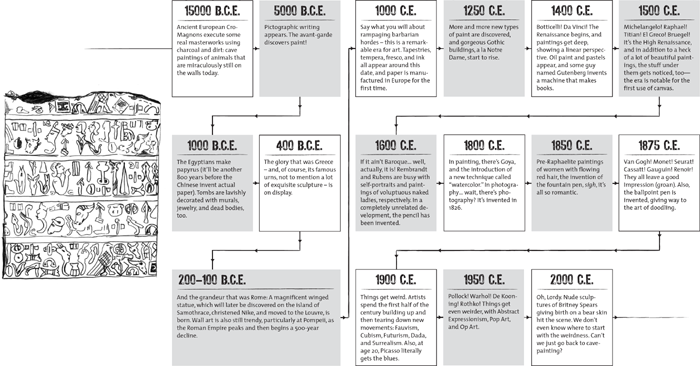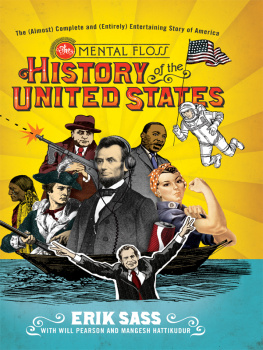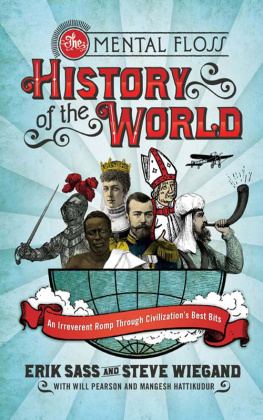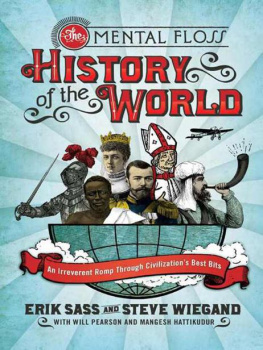mental_floss presents
IN THE BEGINNING
From Big Hair to the Big Bang,
mental_floss presents
a Mouthwatering Guide
to the Origins of Everything
Edited by Mary Carmichael, Will Pearson,
and Mangesh Hattikudur

mental_floss presents: Condensed Knowledge
mental_floss presents: Instant Knowledge
mental_floss presents: Forbidden Knowledge
mental_floss: Cocktail Party Cheat Sheets
mental_floss: Whats the Difference?
mental_floss: The Genius Instruction Manual
mental_floss: Scatterbrained
DEDICATION
For everyone who likes to start at the very beginning
(Its a very good place to start!)
Table of Contents
In the Beginning
Made with only the purest, most organic stories around
IN THE BEGINNING,
God, Odin, the Chaos Dragon Pan-Gu, a couple of Orishas, and Charles Darwin walked into a bar.
A round of your finest ales for me and my friends, Darwin said.
But, of course, his request went unanswered as the world hadnt been created yet. Not only was there no ale and no bar-keep, there wasnt even actually a bar.
Doh, Odin grumbled. I hate it when that happens.
Disappointed by the primordial voids lack of interesting nightlife, the six friends decided to create the Earth (and for real this time, not like last week when they just talked about it). For the most part, the process went smoothly. The six turned the bodies of dead giants into the sky and the land (like you do), established the five-day work week, and formed human beings, cats, frogs, dinosaurs, and other important stuff out of a big batch of Play-Dough they bought at a recent garage sale.
But soon, that first batch of humans proved irresponsible and lazy, falling behind on their mortgage payments and putting a few too many deer-bone necklaces on the old Pangea Express Card. Saddened by the humans failure, the six friends sent Sid, Repo Man of the Gods, to take the Earth away from that pack of deadbeats. But, in remembrance of the first humans, the six deities set a sign in the heavens. From then, lo until the end of time, mankind would be plagued by unsolicited credit card offers to remind them of their financial obligations and how their predecessors were cast out of paradise.
And that, according to our parents, is how the world began. Naturally, growing up with such a rich cultural heritage, we were inspired to further study the origins of Earth as adults. But, as it turns out, a lot of those stories are pretty similar. Theres really only so many times you can recite the deity gets lonelycreates Earth-makes peopledestroys Earthbrings it back storyline before your friends start forgetting to invite you to dinner parties.
So, to spice up our knowledge base, we started delving into the origins of stuff other than life, the universe, and everything. Where did the first pair of blue jeans come from? we wondered. Who invented graffiti? And exactly when and where did the first refrigerator start running?
You might be prone to assuming that this new train of thought runs on a slightly smoother track than our old one. You would be wrong. Not only was this new research a heck of a lot more complicated, it also didnt have as many obvious monetary rewards (we used to make a small killing off the random religious institution lecture circuit). Thats why, when our publishers approached us with the idea to write a book about origins, we pretty much had no choice but to jump. And now you know the origin of our interest in origins. One origin down, 199 to go!
Enjoy,
Maggie Koerth-Baker
 ART: PAINT LIFE GRAND?
ART: PAINT LIFE GRAND?
 THE MASTERS PIECES
THE MASTERS PIECES
 PHOTOGRAPHY
PHOTOGRAPHY
 FAMOUS FLICKS
FAMOUS FLICKS
 MOVIE STARS
MOVIE STARS
 FAMOUS MUSIC
FAMOUS MUSIC
 MUSICAL NOTATION
MUSICAL NOTATION
 JAZZ
JAZZ
 BROADWAY
BROADWAY
 DANCING (FOR FUN)
DANCING (FOR FUN)
 DANCING (FOR PROFIT)
DANCING (FOR PROFIT)
 LITERATURE
LITERATURE
 SHAKESPEARE
SHAKESPEARE
 REFERENCE BOOKS
REFERENCE BOOKS
 THE WASTE LAND
THE WASTE LAND
 SHERLOCK HOLMES
SHERLOCK HOLMES
 NEWSPAPERS AND MAGAZINES
NEWSPAPERS AND MAGAZINES
WHAT :
ART: PAINT LIFE GRAND?
WHY :
Tracing the history of art is, well, an art, not a science - so all dates are very approximate. Also, theyre approximate because otherwise we couldnt fit the entire history of art into two heavily illustrated pages.

WHAT :
THE MASTERS PIECES
WHY :
While art encompasses everything from Leonardo da Vinci to Lenny, that kid with the sidewalk chalk, some works tend to transcend. Heres what we found when we canvassed their history.
Statue of David
The giant marble block that later became the famous statue David had a storied history. Forty years before Michelangelo got his hands on it, the five-meter stone had been quarried for use by sculptor Agostino di Duccio, then an assistant to the master, Donatello. Di Duccio envisioned an enormous statue of David suspended from a Florence cathedrals buttresses, but after two years of hacking away at the rock, he gave up. (Like many of historys finest quitters, he blamed his tools, and cursed the marble for being too difficult to work with.)
Di Duccios partially sculpted block sat untouched until 1474, when the sculptor Antonio Rossellino tried his hand at it, but it bested him after only a few months. (He too complained about the marbles intractability.) Finally, in 1501, the daunting task of finding the David in that now-spoiled rock was assigned to Michelangelo, just 26 years old at the time. Adding to his already thorny challenge, he promised to complete the statue without cutting it down significantly or adding any new pieces of marble to it.
Next page











 ART: PAINT LIFE GRAND?
ART: PAINT LIFE GRAND?